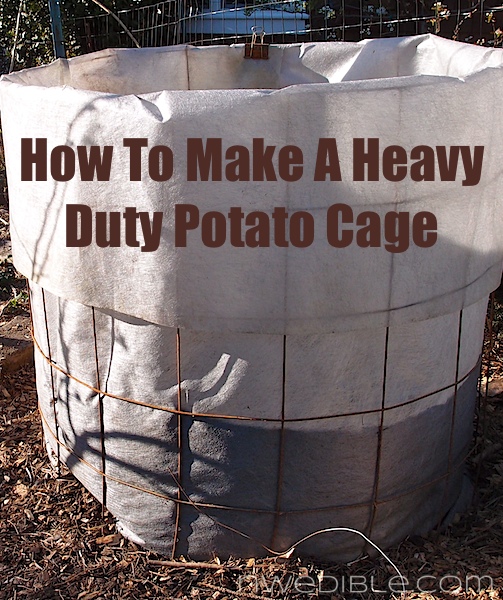How To :: Building Potato Cages
 Potatoes are one of the most often requested vegetables when I first meet with clients, and they're a great crop to grow if you have limited space. Potatoes are a 'tuber', an underground, fleshy stem bearing buds that eventually turn into the potato. (Jerusalem artichokes aka sunchokes are tubers, too.) Dahlias are also tubers, but those roots are simply food-storing roots for the plant.
Once the potato seed is planted (check out this detailed post with pics for details), the seed (which is a small cut piece of a potato with a sprouted 'eye') will put on top growth - a leafy part of the plant that develops in about 4 weeks after planting. This leafy bit produces leaves and flowers. As the plant stem grows, they produce too much energy for the plant and this energy is then stored in the 'tubers', which we call potatoes. Get it? Good.
Potatoes are one of the most often requested vegetables when I first meet with clients, and they're a great crop to grow if you have limited space. Potatoes are a 'tuber', an underground, fleshy stem bearing buds that eventually turn into the potato. (Jerusalem artichokes aka sunchokes are tubers, too.) Dahlias are also tubers, but those roots are simply food-storing roots for the plant.
Once the potato seed is planted (check out this detailed post with pics for details), the seed (which is a small cut piece of a potato with a sprouted 'eye') will put on top growth - a leafy part of the plant that develops in about 4 weeks after planting. This leafy bit produces leaves and flowers. As the plant stem grows, they produce too much energy for the plant and this energy is then stored in the 'tubers', which we call potatoes. Get it? Good.
The trick with growing potatoes then, is to cultivate a healthy environment so that each stem produces as many tubers as possible. To do this, after some stem and leaves develop, we slowly mulch the beds with hay which helps to hold in moisture and also creates a growing medium for the tubers. When mulching, aim to leave about 3 to 4 inches of stem exposed and add hay as needed.
NOW - how to actually GROW potatoes? There are several techniques, and I've tried them all over the years. The most common is called "hilling" - dig a 6-8" trench, drop in cut & sprouted potato seeds and fill the trench halfway with soil. As the plant grows its vine, you continue covering the trench, leaving about 8" of covered seed - all the more volume to grow in. This is the old school farm-y way, but can be difficult for urban farmers with limited space.
 I've successfully grown potatoes in a soil bag on my apartment garden deck, in burlap bags at Volunteer Park Cafe and in trenches when I have the space. This year, I came across a post by Erica over at Northwest Edible Life, wherein she built potato 'cages' - tall planters made from cementing mesh and landscape fabric. You essentially make circular beds with the fencing and line them with landscape fabric to hold in the soil. Building tomato cages is cheap and easy to do, so I added some to Volunteer Park Cafe this year. One roll of 5 foot tall, 100' long concrete mesh cost me $35 at Stoneway Hardware. I had saved up some cool looking vintage feed bags a few years ago, and lined the beds with this instead, but landscaping fabric also works well and looks decent. Erica has a long, detailed How To post that I highly recommend you read. And she posted her results after trying this new potato-making project, which are also great food for thought.
I've successfully grown potatoes in a soil bag on my apartment garden deck, in burlap bags at Volunteer Park Cafe and in trenches when I have the space. This year, I came across a post by Erica over at Northwest Edible Life, wherein she built potato 'cages' - tall planters made from cementing mesh and landscape fabric. You essentially make circular beds with the fencing and line them with landscape fabric to hold in the soil. Building tomato cages is cheap and easy to do, so I added some to Volunteer Park Cafe this year. One roll of 5 foot tall, 100' long concrete mesh cost me $35 at Stoneway Hardware. I had saved up some cool looking vintage feed bags a few years ago, and lined the beds with this instead, but landscaping fabric also works well and looks decent. Erica has a long, detailed How To post that I highly recommend you read. And she posted her results after trying this new potato-making project, which are also great food for thought.
To check out side by side growth, I encourage all of you to head up to Volunteer Park Cafe one afternoon soon (Agnes, my gardner cohort is there on Wednesday afternoons and I'm there one day a week, too - say hi!) and check out both the NW Edible-style planters aka potato cages and our burlap bag planters. Two different techniques side by side makes for a nice afternoon conversation! And don't forget to grab a pastry - that obviously makes the visit sweeter.
ps - You can plant potatoes (in the Pac NW) from TODAY through mid-June, so get crackin' and feel free to email me your project pics so I can share!! amy AT amy DASH pennington DOT com.
pps - I'll write a follow up post on How & When To Harvest potatoes, what to plant next in the cages and some other techniques for potato-growing 2015. Stay tuned!

